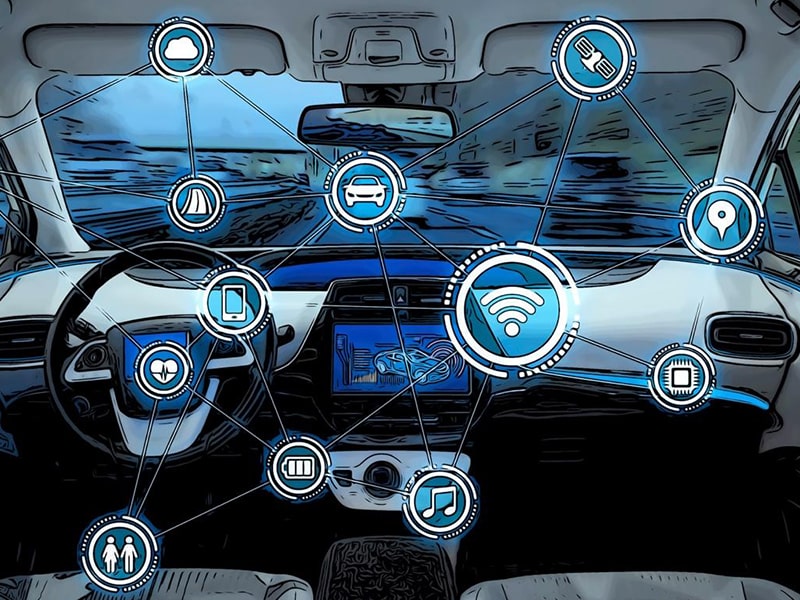
For 100 years a good car was defined as good hardware that manages the constant combustion it needed to drive well but that century is over and software now determines all and everything in a battery electric vehicle. What sounds like a paradigm shift and revolution is one that changes the world we are living in. Most manufacturers who don’t believe this to be true will be sooner or later out of business or shrink to a fraction of the size they’ve been.

The German Automakers Volkswagen, Audi, Porsche, Mercedes-Benz, and BMW are known for their incredible skills in assembling a vehicle be it awesome panel gaps, the best ICE engines with high reliability and performance, or the unique sound a car door makes when closing. It became over the decades their identity and helped to achieve a reputation of true luxury and premium prices. A position no other large automaker be it from North America, Asia, or Europe could ever challenge – until today.
That identity is seriously questioned with the transformation to battery electric vehicles where software plays a critical role in determining the customer experience even more than the hardware ever did. Software is the magic part in a new electric area of the automotive industry that if not mastered overshadows and eliminates the identity of legacy automakers and without identity, there is nothing left to sell.
In the age of electrification and digitalization, good hardware that once was the identity of a product is today just the shell of good or bad software, and the shell is associated with what the software can provide. Brand loyalty today depends on how well or poorly the software works in a vehicle, but the software is outsourced to suppliers by most automakers, and so is brand loyalty.
Since function determines form, most of the products we spend our lives with, whether TVs, smartphones, or computers, look very similar after the transformation took place and hardly differ in their design anymore. Sometimes I even must search for the brand batch because they look so similar from the outside. True brand recognition and differentiation are not achieved with hardware anymore but with the piece of invisible software in the hardware.
Before the touchscreen of the iPhone revolutionized the market the variety of phone hardware design was huge but today, they look all so similar, and still, consumers will argue with you emotionally about which one is better and that is because of the software differences. It’s not a discussion anymore if a keyboard is better or a touchscreen it’s a standard feature average consumers simply expect. What happened to the phone, computers, and television industry before is happening right now to the automotive industry.
When Tesla presented the Model 3 with a spartan interior, and huge center displays the first reaction of the media and average consumers were negative but today we see most car companies copying the hardware design from Tesla one way or the other. Be it centered large displays, fewer or even no shifters, fewer buttons, a frunk or more interior space BEVs develop over time in their design in the same direction. Many elements Tesla designed, and their owners love are gradually incorporated into other brands and over time we may see the same development into an equalization or harmonization other electronic industries went through over the years too.
A huge touch screen is today a given in a good electric vehicle simply because it offers many benefits in terms of usability, information, and customer experience but if it’s missing customers will complain or take another brand. The interior is following the new needs a driver has in a time where vehicles develop gradually but steadily into driving assist and autonomous vehicles. The exterior is following the needs a driver has with a range of his electric vehicle where low wind resistance is a must that in return determines the form of your car.
The desperate attempt of legacy automakers to transport the look and feel of internal combustion engine vehicles into the battery electric car age will fail if they don’t understand that the loyalty of the future customer can only be won with the software while the hardware is less important. Image and personalization are expressed with software options every driver can adjust to his personal taste and need. Be it the acceleration and braking behavior of the vehicle, the design and functional arrangement of elements on the user interface, or the vehicle sound – all of these can be set by the driver to express his or her personality.
The Bauhaus movement taught 100 years ago that function defines the form and that’s what is happening to BEVs whose function is different from the one of ICE vehicles. It’s true that both vehicles drive and transport passengers but that’s about all that they have in common. People who drive a battery electric vehicle are reluctant to sit in an ICE vehicle again for a good reason. The last time I was in an ICE car was 3.5 years ago before I sold my Porsche Cayman.
But what does all that mean for the software of a BEV? The innovation of the consumer software industry has since its inception synthesized into three to four standards per device where most of the revenue and profits are made and the same can be expected from the automotive industry with regards to BEVs. In the future, we will have just a handful of options of software solutions we can choose from left but a larger variety of variations in how we customize the software for our specific BEV than we ever had in 100 years of internal combustion engines.
Already today a good BEV can be customized by its owner to an extent ICE vehicles have never been capable of and we are just at the beginning of that new innovative revolution. Despite only a handful of operating software systems remaining in the future electric vehicle world, the variety of options for how owners can design their individual software to fulfill their personal needs will be bigger than ever. Every owner of a good BEV today understands the added value he receives so quickly that any car that does not provide it is for him outdated and an old, not usable technology.
We are in the early years of a transformation where the software will become what the hardware was once – the status symbol of car owners. You will still be able to identify the brand if you see a BEV but the association of what it can do for you and what you feel about it will be fully accomplished by its software. One reason for that is not only that software defines the driving experience, dynamics, and services but the data you create while driving is a very important source for software improvement, customer services, and even income generation for its owners. Algorithms that get access to the data allow continuous improvement in various aspects of the services and car ownership.
The first expressions of that new data-driven customer ecosystem are visible with individualized car insurances providing better coverage and premiums for lower costs. But that’s just the start and the world will see an entirely new ecosystem developing that uses driving data as well as the time a consumer will have in his fully autonomous vehicle for his benefit. While many still deny that autonomous vehicles exist at all, the reality is that consumers driving in an autonomous Waymo (Google), Cruise (GM), or FSD-Bata (Tesla) already today. Regardless of to what extent they drive autonomously and where precious lifetime has been given back to them that they can spend as they wish. Be it gaming, making phone calls or video conferences, sleeping, or thinking consumers will be physically locked in a box and are available for offerings on how to spend that unlocked time. Directly or indirectly, they will spend money that they couldn’t when they were still driving.
When you see a Tesla vehicle in North America today, you may not even be able to tell from the outside if it’s a Model 3 or a Model Y because they look so similar and the same is true for its capabilities. You don’t know from the outside if it has basic Autopilot features or advanced ADAS that allows you to automatically change lanes on the highway, or if it’s even capable of driving anywhere for hours like a fully autonomous vehicle with FSD Beta, without any driver intervention. You simply can’t see the difference from the outside, but when you’re in the car yourself, you know very well that your Tesla is different. That personalization and uniqueness create brand loyalty no one without that software capability can compete with. The differentiation from any other vehicle brand and model is so dramatic that it’s fair to say that there isn’t any competition.
The top managers of the legacy car manufacturers do not have a decent and deep understanding of software and are therefore not fit for the job. They have made careers and risen to board positions while being successful with the management and sales of ICE vehicles in a time when the software did not play the role it has today. The top managers of the legacy automakers have risen to the highest level of incompetence that their limited software expertise has allowed them, and they are doing everything they can to keep it.
An incompetence they have proven with their endless chain of wrong strategic decisions since the first BEVs have been sold by Tesla. The dramatic shrinking in unit sales and technology leadership of legacy automakers is proof that what was right in the past decades is not anymore today. Over time this will after sharply decreasing unit sales become painfully visible in revenue and profits and at that time many shareholders who have thought their investment is paying back will start to understand they have been cheated.
A company like Porsche, which has only one BEV model with declining sales of about 40,000 units per year in addition to around 260,000 ICE vehicles, which management promises to reduce to zero in the next eight years, has no justification for claiming a company valuation of 75 billion euros. There is simply no margin or profit expectation to justify a valuation at this level if there is no software competence for future innovation. Porsche has negotiated a get-out clause for the new operating system VW’s software subsidiary Cariad is developing for the group if it can’t deliver on time or in good quality, which is a sign that Porsche CEO Oliver Blume doesn’t have faith in VW’s group CEO Oliver Blume to deliver on his agreements. If the CEO doesn’t believe he can deliver good software on time, why should a shareholder?
Currently, there is not a single legacy automaker in the world that has proven they are capable of developing and delivering good software for their battery-powered electric vehicles, which disqualifies them all as a good investment and a company with a future.
The sad thing is not even that most of them have no future or are shrinking into niche players – the sad thing is that their executives don’t understand what’s happening. As long as people who haven’t made a career in software run automotive companies, their future is doomed.
About the author
Alex Voigt has been a supporter of the mission to transform the world to sustainable carbon free energy and transportation for 40 years. As an engineer, he is fascinated about the ability of humankind to develop a better future via the use of technology. As a German, he is sometimes frustrated about the German automotive industry and its slow progress with battery electric vehicles which is why he started to publish in English and German. With 30 years of experience in the stock market, he is invested in Tesla [TSLA], as well as some other tech companies, for the long term.











